








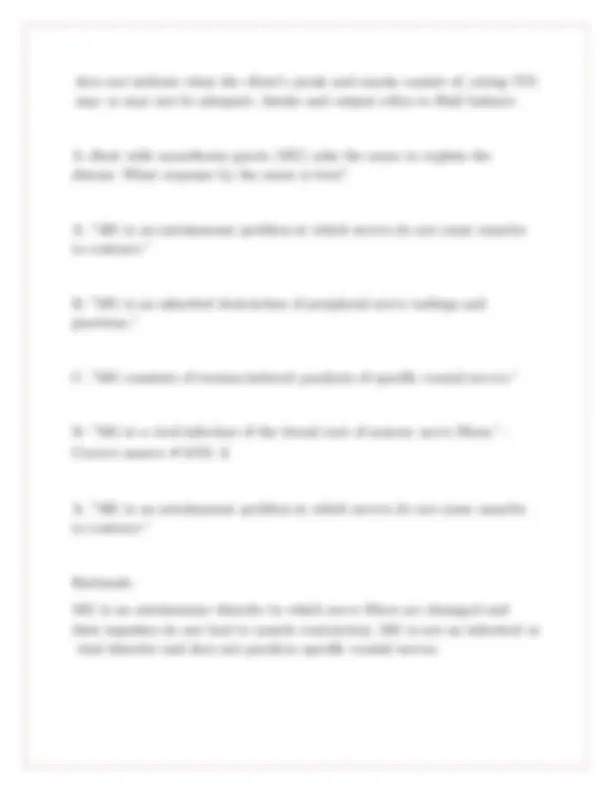










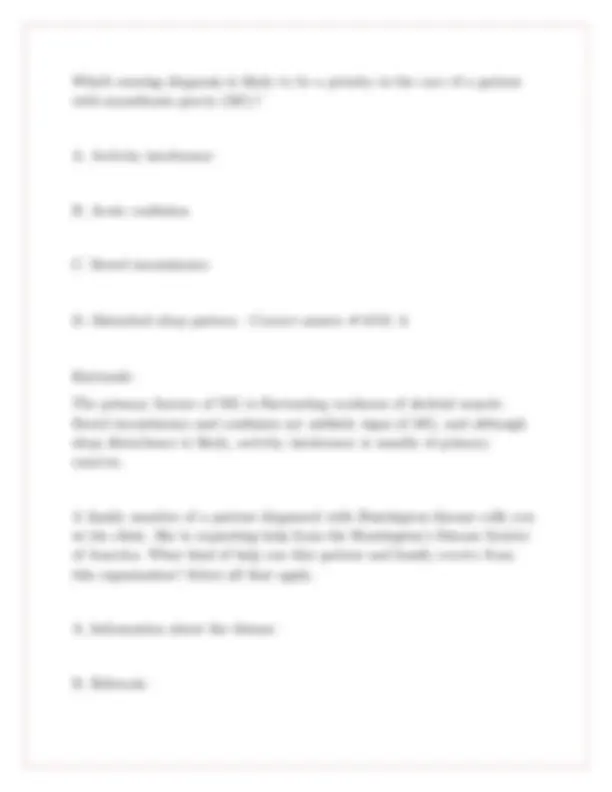
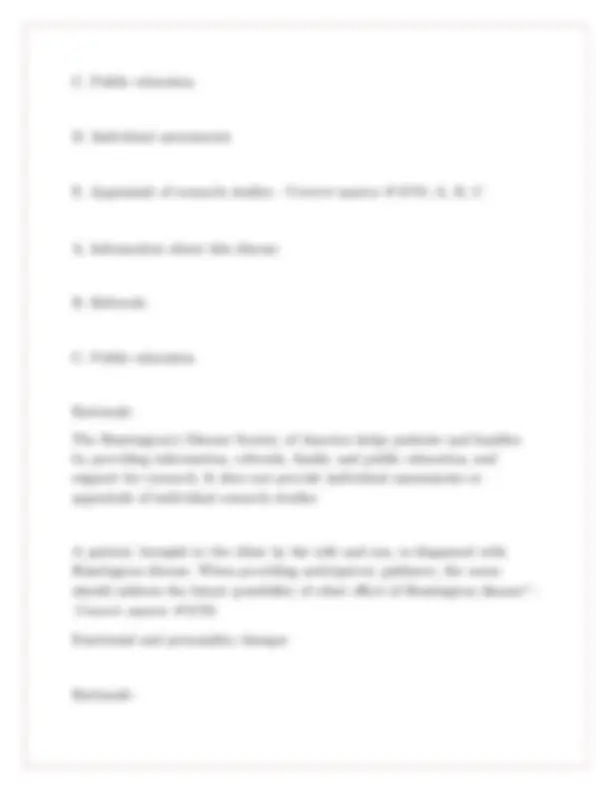
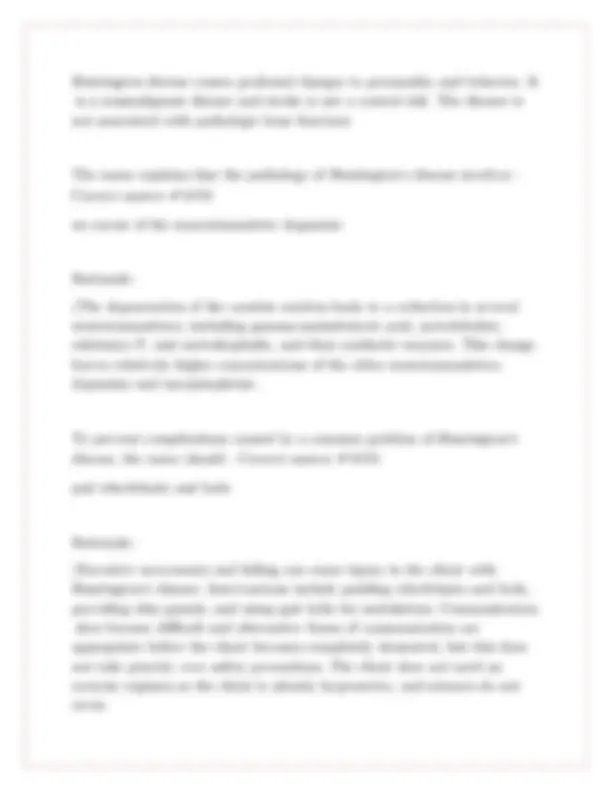






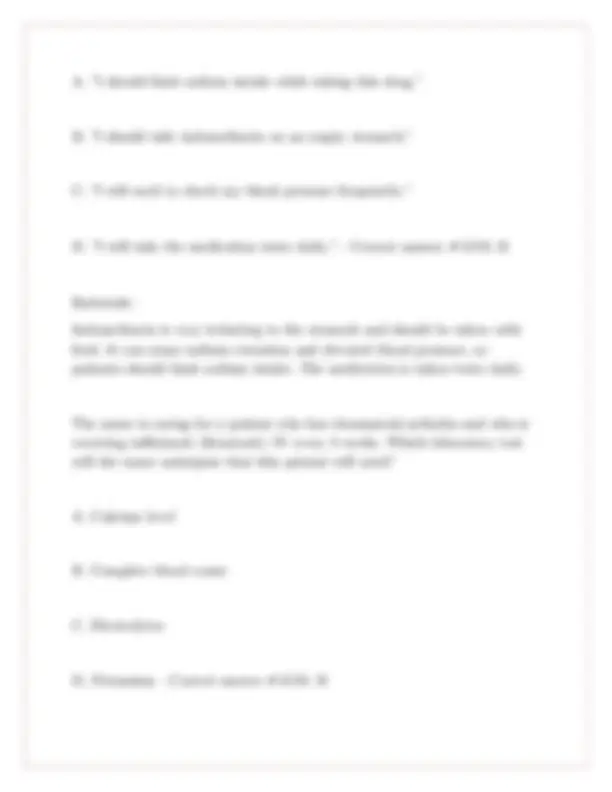
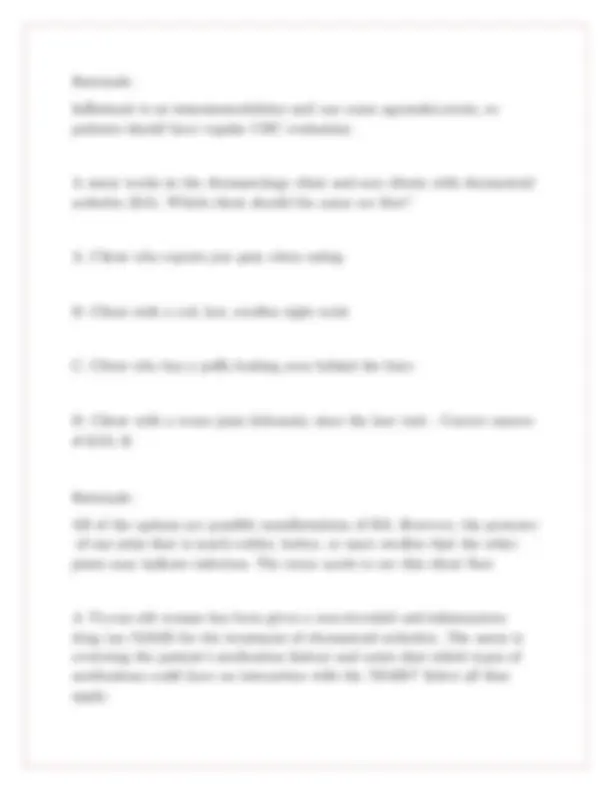

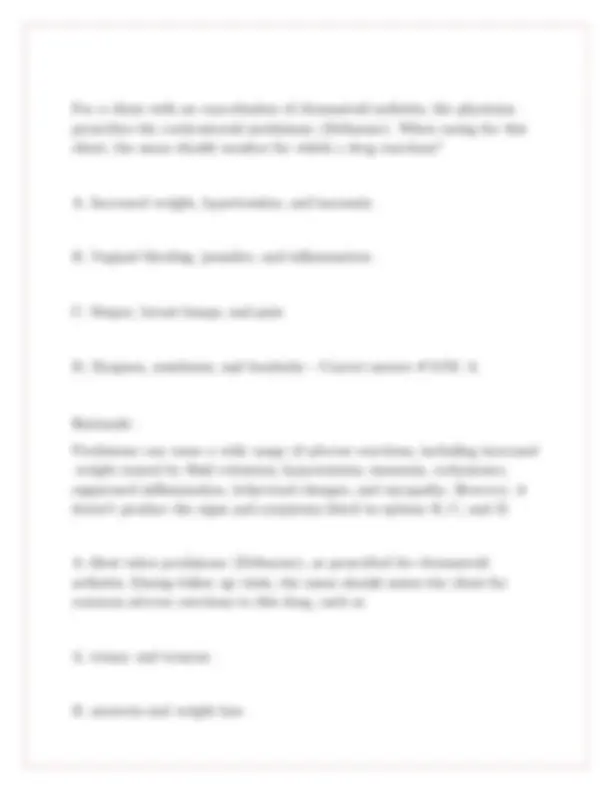



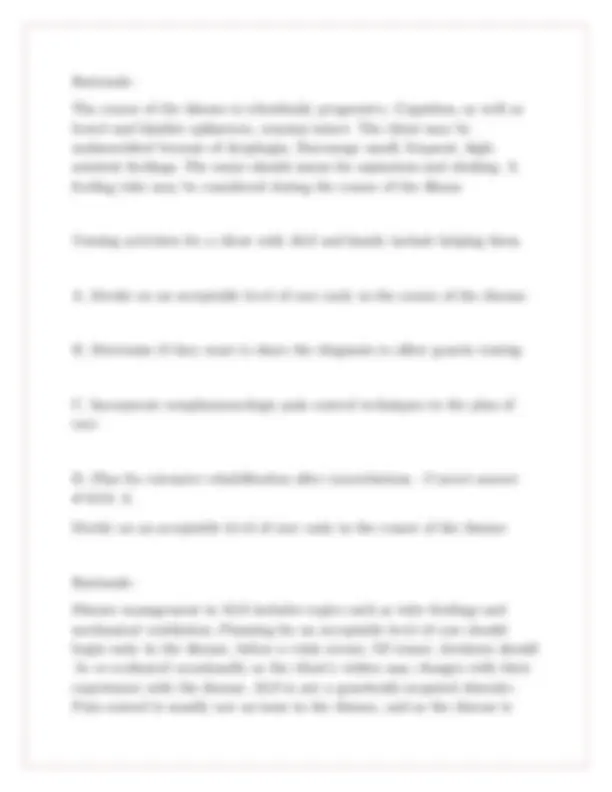


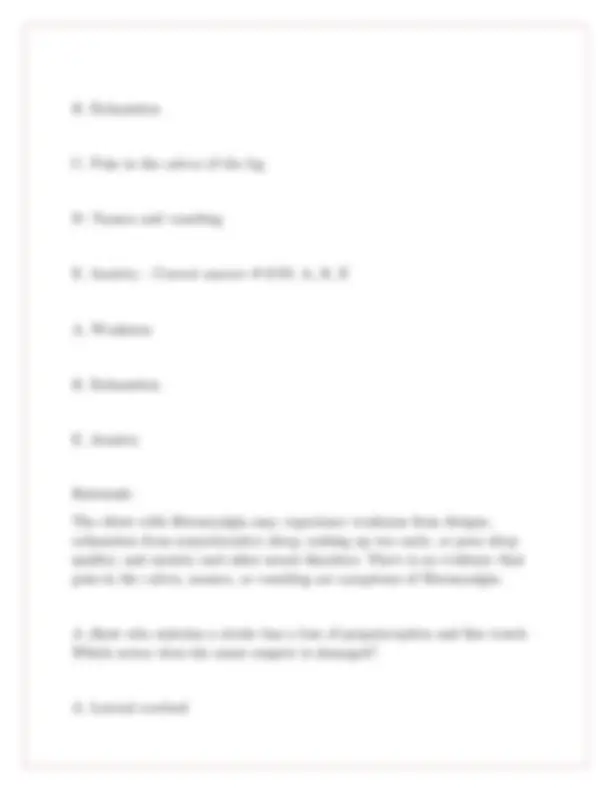







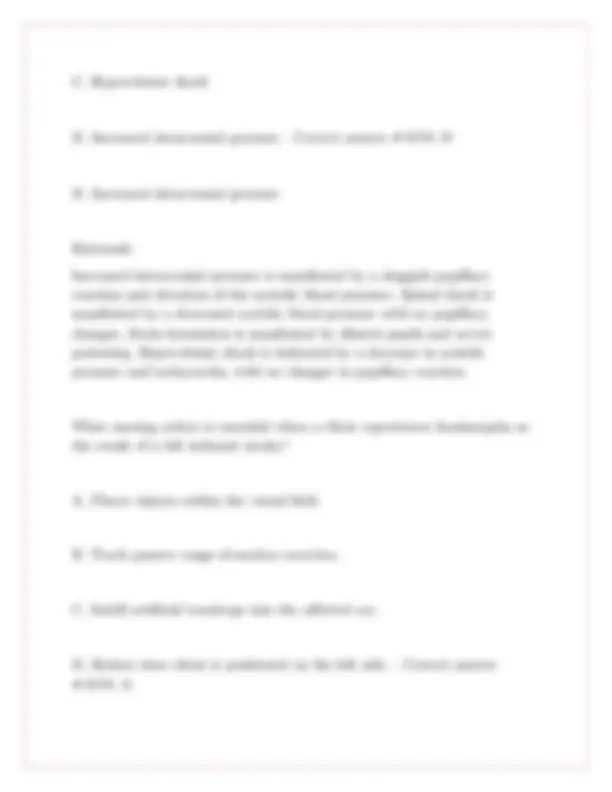






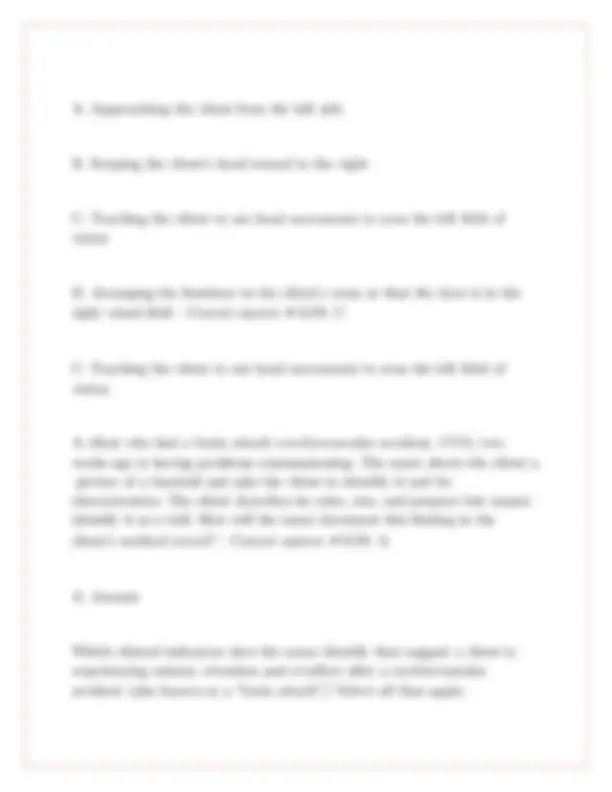








Study with the several resources on Docsity

Earn points by helping other students or get them with a premium plan


Prepare for your exams
Study with the several resources on Docsity

Earn points to download
Earn points by helping other students or get them with a premium plan
Community
Ask the community for help and clear up your study doubts
Discover the best universities in your country according to Docsity users
Free resources
Download our free guides on studying techniques, anxiety management strategies, and thesis advice from Docsity tutors
MS2- EXAM 3- Possible Test Blue Print Questions with precise detailed answer
Typology: Exams
1 / 68

This page cannot be seen from the preview
Don't miss anything!





























































The |! nurse |! is |! preparing |! to |! care |! for |! a |! patient |! who |! has |! myasthenia |! gravis. |! The |! nurse |! will |! be |! alert |! to |! symptoms |! affecting |! which |! body |! system |! in |! this |! patient? |! - |! Correct |! answer |! ✔ANS: |! Respiratory |! system |! and |! facial |! muscles Rationale: Myasthenia |! gravis |! causes |! fatigue |! and |! muscular |! weakness |! of |! the |! respiratory |! system, |! facial |! muscles |! and |! extremities. |! It |! does |! not |! directly |! affect |! the |! cardiovascular |! system, |! CNS, |! or |! GI |! systems. A |! 40-year-old |! woman |! is |! diagnosed |! with |! myasthenia |! gravis, |! and |! her |! provider |! recommends |! removal |! of |! her |! thymus |! gland. |! She |! asks |! the |! nurse |! why |! this |! would |! be |! helpful. |! The |! nurse |! will |! explain |! that |! the |! removal |! of |! the |! thymus |! gland |! may |! - |! Correct |! answer |! ✔ANS: reduce |! the |! autoimmune |! destruction |! of |! ACh |! receptor |! sites Rationale: Myastehnia |! gravis |! is |! an |! autoimmune |! disorder |! involving |! an |! antibody |! response |! against |! a |! subunit |! of |! the |! ACh |! receptor |! site. |! Since |! the |! thymus |! is |!
involved |! in |! systemic |! immunity, |! it |! is |! thought |! that |! removing |! the |! thymus |! can |! inhibit |! this |! process. |! It |! does |! not |! increase |! binding |! of |! ACh |! molecules |! to |! receptors |! or |! increase |! the |! amount |! of |! ACh |! or |! reduce |! the |! number |! of |! ACh |! receptor |! sites. The |! nurse |! assumes |! care |! of |! a |! patient |! who |! has |! myasthenia |! gravis |! and |! notes |! that |! a |! dose |! of |! neostigmine |! (Prostigmin) |! due |! 1 |! hour |! prior |! was |! not |! given. |! The |! nurse |! will |! anticipate |! the |! patient |! to |! exhibit |! which |! symptoms? |! - |! Correct |! answer |! ✔ANS: MUSCLE |! WEAKNESS Rationale: Neostigmine |! must |! be |! given |! on |! time |! to |! prevent |! myasthenic |! crisis, |! which |! is |! characterized |! by |! generalized, |! severe |! muscle |! weakness. |! Excessive |! salivation, |! muscle |! spasms |! and |! respiratory |! paralysis |! are |! characteristic |! of |! cholinergic |! crisis, |! caused |! by |! too |! much |! medication. The |! nurse |! is |! caring |! for |! a |! patient |! who |! has |! myasthenia |! gravis |! (MG) |! and |! takes |! pyridostigmine |! bromide |! (Mestinon) |! 60 |! mg |! every |! 4 |! hours. |! The |! patient's |! last |! dose |! was |! 45 |! minutes |! prior. |! The |! nurse |! notes |! severe |! muscle |! weakness, |! excessive |! salivation, |! fasciculations |! of |! facial |! muscles, |! and |! pupil |! constriction. |! The |! nurse |! will |! perform |! which |! action? |! - |! Correct |! answer |! ✔ANS: Obtain |! an |! order |! for |! ATROPINE |! SULFATE Rationale: Severe |! muscle |! weakness, |! excess |! salivation, |! fasciculations |! of |! facial |! muscles, |! and |! pupil |! constriction |! are |! the |! major |! signs |! of |! cholinergic |! crisis, |! caused |! by |!
B. |! Edrophonium |! bromide |! (Tensilon) C. |! Intravenous |! immune |! globulin |! (IVIG) D. |! Pyridostigmine |! HCl |! (Mestinon) |! - |! Correct |! answer |! ✔ANS: |! D D. |! Pyridostigmine |! HCl |! (Mestinon) Rationale: In |! this |! case, |! edrophonium |! is |! used |! to |! diagnose |! myasthenia |! gravis. |! Since |! symptoms |! improved |! with |! the |! AChE |! inhibitor, |! the |! patient |! will |! benefit |! from |! a |! longer-acting |! AChE |! inhibitor |! such |! as |! pyridostigmine. |! Atropine |! is |! given |! for |! AChE |! inhibitor |! overdose. |! Edrophonium |! is |! very |! short-acting, |! so |! it |! will |! not |! be |! used |! for |! treatment. |! IVIG |! is |! used |! when |! other |! AChE |! inhibitors |! fail. A |! patient |! exhibits |! ptosis |! of |! both |! eyes, |! and |! the |! provider |! orders |! edrophonium |! (Tensilon). |! The |! nurse |! notes |! immediate |! improvement |! of |! the |! ptosis. |! The |! nurse |! understands |! that |! this |! patient |! most |! likely |! has |! which |! disorder? |! - |! Correct |! answer |! ✔ANS: Myasthenia |! gravis Rationale: Improvement |! of |! symptoms |! after |! administration |! of |! edrophonium |! is |! diagnostic |! for |! myasthenia |! gravis.
The |! charge |! nurse |! observes |! a |! nurse |! administer |! undiluted |! intravenous |! pyridostigmine |! bromide |! (Mestinon) |! at |! a |! rate |! of |! 0.8 |! mg/min. |! The |! charge |! nurse |! will |! stop |! the |! infusion |! and |! perform |! which |! action? A. |! Administer |! atropine |! sulfate |! to |! prevent |! cholinergic |! crisis B. |! Monitor |! the |! patient |! closely |! for |! respiratory |! distress C. |! Suggest |! that |! the |! nurse |! dilute |! the |! medication |! with |! colloidal |! fluids |! D. |! Tell |! the |! nurse |! to |! slow |! the |! rate |! of |! infusion |! of |! the |! pyridostigmine |! - |! Correct |! answer |! ✔ANS: |! D. |! Tell |! the |! nurse |! to |! slow |! the |! rate |! of |! infusion |! of |! the |! pyridostigmine. Rationale: When |! given, |! IV |! pyridostigmine |! should |! be |! administered |! undiluted |! at |! a |! rate |! of |! 0.5 |! mg/min |! and |! should |! not |! be |! added |! to |! IV |! fluids. |! It |! is |! not |! necessary |! to |! administer |! atropine, |! since |! the |! patient |! is |! not |! symptomatic |! of |! cholinergic |! crisis. A |! patient |! reports |! weakness |! of |! the |! extremities |! and |! diplopia. |! The |! nurse |! knows |! that |! these |! symptoms |! are |! characteristic |! of |! which |! condition? A. |! Cerebral |! palsy |! (CP)
E. |! Drooling F. |! Weakness |! - |! Correct |! answer |! ✔ANS: |! A, |! C, |! E, |! F Rationale: Bradycardia, |! vomiting, |! drooling, |! and |! weakness |! can |! all |! occur |! with |! cholinergic |! crisis. |! DOES |! VOMITING |! HAPPEN?? A |! client |! with |! myasthenia |! gravis |! and |! his |! family |! are |! receiving |! instructions |! from |! the |! nurse. |! The |! nurse |! teaches |! the |! client |! that |! insufficient |! dosing |! of |! cholinesterase |! inhibitor |! may |! result |! in |! myasthenia |! crisis. |! The |! client |! is |! taught |! about |! which |! signs |! and |! symptoms |! of |! myasthenia |! crisis? A. |! Decreased |! muscle |! strength |! in |! the |! lower |! extremities B. |! Increased |! salivation |! and |! sweating C. |! Muscle |! weakness |! and |! increased |! salivation D. |! Muscle |! weakness, |! difficulty |! breathing |! and |! swallowing |! - |! Correct |! answer |! ✔ANS: |! D D. |! Muscle |! weakness, |! difficulty |! breathing |! and |! swallowing |!
Rationale: These |! are |! the |! major |! signs |! of |! myasthenia |! gravis, |! which |! may |! be |! undertreated |! with |! insufficient |! dosing |! of |! the |! medication. |! Increased |! salivation |! is |! related |! to |! cholinergic |! crisis. As |! a |! part |! of |! a |! teaching |! session, |! a |! client |! with |! myasthenia |! gravis |! and |! her |! family |! are |! receiving |! instructions |! from |! the |! nurse. |! The |! nurse |! teaches |! the |! client |! that |! overdosing |! of |! cholinesterase |! inhibitor |! may |! result |! in |! cholinergic |! crisis. |! The |! client |! is |! taught |! about |! which |! signs |! and |! symptoms |! of |! cholinergic |! crisis? A. |! Decreased |! muscle |! strength |! and |! decreased |! salivation B. |! Increased |! salivation |! and |! sweating C. |! Muscle |! weakness |! and |! increased |! salivation D. |! Muscle |! spasticity |! and |! decreased |! salivation |! - |! Correct |! answer |! ✔ANS: |! C C. |! Muscle |! weakness |! and |! increased |! salivation Rationale: These |! are |! the |! major |! signs |! of |! cholinergic |! crisis.
D. |! Atropine |! sulfate |! - |! Correct |! answer |! ✔ANS: |! D D. |! Atropine |! sulfate Rationale: These |! are |! the |! major |! signs |! of |! cholinergic |! crisis; |! the |! client |! would |! be |! treated |! with |! the |! antidote, |! atropine |! sulfate. A |! client |! with |! myasthenia |! gravis |! demonstrates |! diplopia, |! ptosis, |! and |! dysphagia. |! The |! client |! is |! ordered |! to |! receive |! pyridostigmine |! bromide |! (Mestinon). |! What |! would |! indicate |! a |! positive |! outcome? A. |! Increase |! in |! the |! ability |! to |! sleep B. |! Decrease |! in |! muscle |! weakness C. |! Increase |! in |! hemiparesis D. |! Decreased |! metabolic |! rate |! - |! Correct |! answer |! ✔ANS: |! B B. |! Decrease |! in |! muscle |! weakness Rationale:
A |! decrease |! in |! weakness |! would |! indicate |! a |! positive |! response. The |! nurse |! recognizes |! that |! a |! dose |! of |! an |! AChE |! inhibitor |! was |! given |! 1 |! hour |! late. |! The |! nurse |! anticipates |! that |! the |! client |! will |! exhibit |! which |! symptom |! as |! a |! result |! of |! the |! late |! dosage? A. |! Excessive |! salivation B. |! Difficulty |! breathing C. |! Muscle |! weakness D. |! Bradycardia |! - |! Correct |! answer |! ✔ANS: |! C C. |! Muscle |! weakness Rationale: All |! doses |! of |! AChE |! inhibitors |! should |! be |! administered |! on |! time, |! because |! late |! administration |! of |! the |! drug |! could |! result |! in |! muscle |! weakness. A |! client |! with |! myasthenia |! gravis |! is |! experiencing |! a |! myasthenic |! crisis. |! Which |! symptoms |! are |! associated |! with |! myasthenia |! gravis? |! Select |! all |! that |! apply. A. |! Weakness
C. |! Obtaining |! atropine |! sulfate Rationale: Atropine |! is |! the |! antidote |! to |! edrophonium |! chloride |! and |! should |! be |! readily |! available |! when |! a |! client |! is |! having |! a |! Tensilon |! test. |! The |! nurse |! would |! not |! want |! to |! give |! medications |! that |! might |! cause |! increased |! weakness |! or |! sedation. |! A |! ventilator |! is |! not |! necessary |! to |! have |! nearby, |! although |! emergency |! equipment |! should |! be |! available. A |! client |! is |! taking |! long-term |! cotricosteroids |! for |! myasthenia |! gravis. |! What |! teaching |! is |! most |! important? A. |! Avoid |! large |! crowds |! and |! people |! who |! are |! ill. B. |! Check |! blood |! sugars |! four |! times |! a |! day. |! C. |! Use |! two |! forms |! of |! contraception. D. |! Wear |! properly |! fitting |! socks |! and |! shoes |! - |! Correct |! answer |! ✔ANS: |! A A. |! Avoid |! large |! crowds |! and |! people |! who |! are |! ill |! Rationale:
Corticosteroids |! reduce |! immune |! function, |! so |! clients |! taking |! these |! medications |! must |! avoid |! being |! exposed |! to |! illness. |! Long-term |! use |! can |! lead |! to |! secondary |! diabetes, |! but |! the |! client |! would |! not |! need |! to |! start |! checking |! blood |! glucose |! unless |! diabetes |! had |! been |! detected. |! Corticosteroids |! do |! not |! affect |! the |! effectiveness |! of |! contraception. |! Wearing |! well-fitting |! shoes |! would |! be |! important |! to |! avoid |! injury, |! but |! not |! just |! because |! the |! client |! takes |! corticosteroids. A |! client |! with |! myasthenia |! gravis |! has |! the |! priority |! client |! problem |! of |! inadequate |! nutrition. |! What |! assessment |! finding |! indicates |! that |! the |! priority |! goal |! for |! this |! client |! problem |! has |! been |! met? A. |! Ability |! to |! chew |! and |! swallow |! without |! aspiration B. |! Eating |! 75% |! of |! meals |! and |! between-meal |! snacks C. |! Intake |! greater |! than |! output |! 3 |! days |! in |! a |! row D. |! Weight |! gain |! of |! 3 |! lbs |! in |! 1 |! month |! - |! Correct |! answer |! ✔ANS: |! D D. |! Weight |! gain |! of |! 3 |! lbs |! in |! one |! month Rationale: Weight |! gain |! is |! the |! best |! indicator |! that |! the |! client |! is |! receiving |! enough |! nutrition. |! Being |! able |! to |! chew |! and |! swallow |! is |! important |! for |! eating, |! but |! adequate |! nutrition |! can |! be |! accomplished |! through |! enteral |! means |! if |! needed. |! Swallowing |! without |! difficulty |! indicates |! an |! intact |! airway. |! Since |! the |! question
A |! client |! with |! myasthenia |! gravis |! is |! prescribed |! pyridostigmine |! (Mesinon). |! What |! should |! the |! nurse |! plan |! regarding |! this |! medication? |! Select |! all |! that |! apply. |! A. |! "Do |! not |! eat |! a |! full |! meal |! for |! 45 |! minutes |! after |! taking |! the |! drug." B. |! "Seek |! immediate |! care |! if |! you |! develop |! trouble |! swallowing." C. |! "Take |! this |! drug |! on |! an |! empty |! stomach |! for |! best |! absorption." D. |! "The |! dose |! may |! change |! frequently |! depending |! on |! symptoms." |! E. |! "Your |! urine |! may |! turn |! a |! reddish-orange |! color |! while |! on |! this |! drug." |! - |! Correct |! answer |! ✔ANS: |! A, |! B, |! D A. |! "Do |! not |! eat |! a |! full |! meal |! for |! 45 |! minutes |! after |! taking |! the |! drug." B. |! "Seek |! immediate |! care |! if |! you |! develop |! trouble |! swallowing." D. |! "The |! dose |! may |! change |! frequently |! depending |! on |! symptoms." |! |! Rationale: Pyridostigmine |! should |! be |! given |! with |! a |! small |! amount |! of |! food |! to |! prevent |! GI |! upset, |! but |! the |! client |! should |! wait |! to |! eat |! a |! full |! meal |! due |! to |! the |! potential |! for |! aspiration. |! If |! difficulty |! with |! swallowing |! occurs, |! the |! client |! should |! seek |! immediate |! attention. |! The |! dose |! can |! change |! on |! a |! day-to-day |! basis |! depending
|! on |! the |! client's |! manifestations. |! Taking |! the |! drug |! on |! an |! empty |! stomach |! is |! not |! related |! although |! the |! client |! needs |! to |! eat |! within |! 45 |! to |! 60 |! minutes |! afterwards. |! The |! client's |! urine |! will |! not |! turn |! reddish-orange |! while |! on |! this |! drug. A |! client |! with |! myasthenia |! gravis |! (MG) |! is |! receiving |! cholinesterase |! inhibitor |! drugs |! to |! improve |! muscle |! strength. |! The |! nurse |! is |! educating |! the |! family |! about |! this |! therapy. |! Which |! statement |! by |! a |! family |! member |! indicates |! a |! correct |! understanding |! of |! the |! nurse's |! instruction? |! - |! Correct |! answer |! ✔ANS: "I |! should |! call |! 911 |! if |! a |! sudden |! increase |! in |! weakness |! occurs." Rationale: A |! potential |! adverse |! effect |! of |! cholinesterase |! inhibitors |! is |! cholinergic |! crisis. |! Sudden |! increases |! in |! weakness |! and |! the |! inability |! to |! clear |! secretions, |! swallow, |! or |! breathe |! adequately |! indicate |! that |! the |! client |! is |! experiencing |! crisis. Which |! statement |! correctly |! illustrates |! the |! commonality |! between |! Guillain- Barré |! syndrome |! (GBS) |! and |! myasthenia |! gravis |! (MG)? |! - |! Correct |! answer |! ✔ANS: The |! client's |! respiratory |! status |! and |! muscle |! function |! are |! affected |! by |! both |! diseases. A |! client |! is |! being |! evaluated |! for |! signs |! associated |! with |! myasthenic |! crisis |! or |! cholinergic |! crisis. |! Which |! symptoms |! lead |! the |! nurse |! to |! suspect |! that |! the |! client |! is |! experiencing |! a |! cholinergic |! crisis? |! - |! Correct |! answer |! ✔ANS: Abdominal |! cramps, |! blurred |! vision, |! and |! facial |! muscle |! twitching |! are |! signs |! of |! an |! acute |! exacerbation |! of |! muscle |! weakness |! symptoms |! of |! cholinergic |! crisis |! caused |! by |! overmedication |! with |! cholinergic |! (anticholinesterase) |! drugs.
A. |! "Watch |! for |! signs |! and |! symptoms |! of |! myasthenic |! crisis." B. |! "Take |! the |! drug |! about |! an |! hour |! before |! eating |! a |! meal." C. |! "Take |! the |! same |! dose |! of |! medication |! every |! day." D. |! "Take |! the |! drug |! with |! food |! to |! prevent |! nausea." E. |! "Do |! not |! take |! sedatives |! or |! sleeping |! pills |! while |! on |! this |! drug." |! - |! Correct |! answer |! ✔ANS: |! A, |! B, |! C, |! E Rationale: The |! client |! and |! family |! should |! watch |! for |! an |! exacerbation |! of |! myasthenic |! symptoms |! caused |! by |! underdosing |! of |! anticholinesterase |! drugs. |! The |! client |! should |! eat |! meals |! 45 |! minutes |! to |! 1 |! hour |! after |! taking |! pyridostigmine |! to |! avoid |! aspiration; |! this |! is |! especially |! important |! if |! the |! client |! has |! bulbar |! involvement. |! The |! client |! should |! be |! told |! that |! he |! or |! she |! should |! take |! the |! same |! dose |! of |! medication |! daily |! and |! on |! time |! to |! maintain |! blood |! levels |! and |! improve |! muscle |! strength; |! changing |! doses |! daily |! will |! interfere |! with |! interpretation |! of |! blood |! levels |! and |! adjustment |! of |! the |! doses. |! The |! client |! should |! not |! take |! drugs |! containing |! magnesium, |! morphine |! (or |! its |! derivatives |! curare, |! quinine, |! quinidine, |! procainamide), |! or |! hypnotics |! or |! sedatives |! because |! they |! may |! increase |! weakness. |! The |! client |! should |! not |! take |! pyridostigmine |! with |! food. When |! caring |! for |! a |! client |! with |! myasthenia |! gravis, |! which |! of |! these |! nursing |! activities |! may |! be |! safely |! delegated |! to |! a |! nursing |! assistant? |! Select |! all |! that |! apply. |!
A. |! Feeding |! dinner |! to |! the |! client B. |! Teaching |! the |! family |! about |! drug |! therapy C. |! Assisting |! with |! client |! communication D. |! Consulting |! with |! the |! physical |! therapist |! E. |! Assisting |! with |! ambulation F. |! Recording |! food |! and |! fluid |! intake |! - |! Correct |! answer |! ✔ANS: |! A, |! C, |! E, |! F Rationale: The |! nursing |! assistant |! may |! assist |! with |! client |! feeding, |! communication, |! ambulation, |! and |! recording |! food |! and |! fluid |! intake. |! Any |! difficulties |! that |! arise |! when |! assisting |! the |! client |! with |! these |! activities |! should |! be |! reported |! immediately |! to |! the |! registered |! nurse. |! The |! nurse |! is |! responsible |! for |! education |! related |! to |! drug |! therapy, |! indications |! for |! use, |! dosages, |! and |! adverse |! reactions, |! as |! well |! as |! interdisciplinary |! collaboration. |! However, |! the |! nursing |! assistant |! may |! assist |! the |! physical |! therapist |! at |! the |! bedside |! or |! communicate |! with |! him |! or |! her. The |! nurse |! is |! caring |! for |! a |! client |! with |! myasthenia |! gravis. |! What |! is |! essential |! for |! the |! nurse |! to |! teach |! this |! client |! regarding |! treatment?